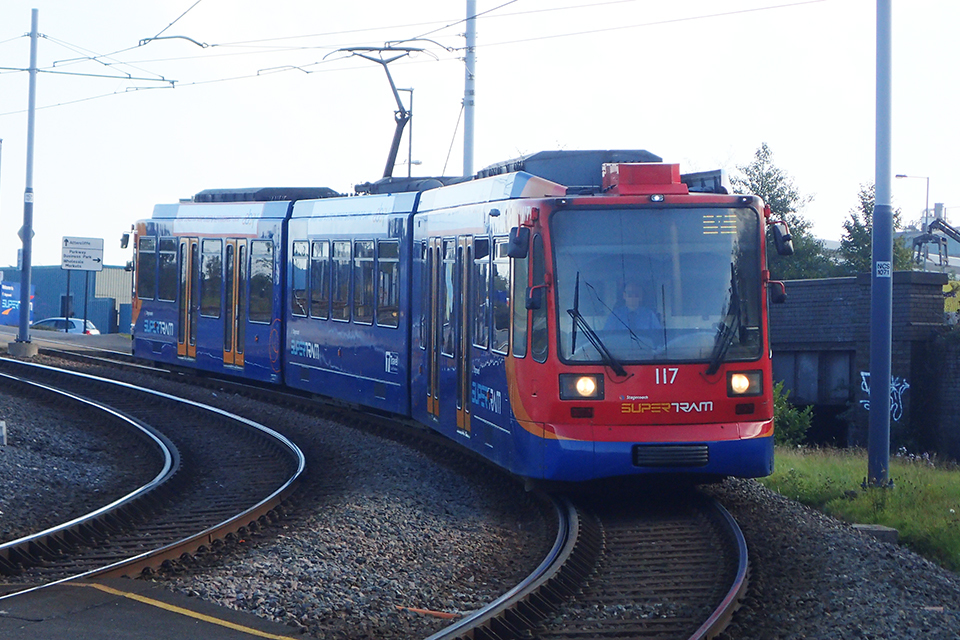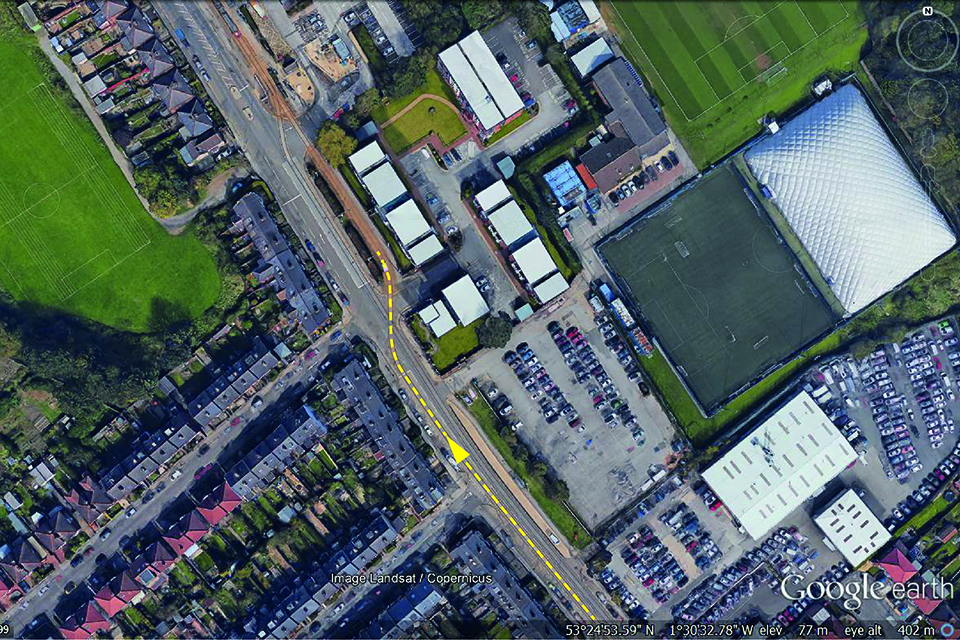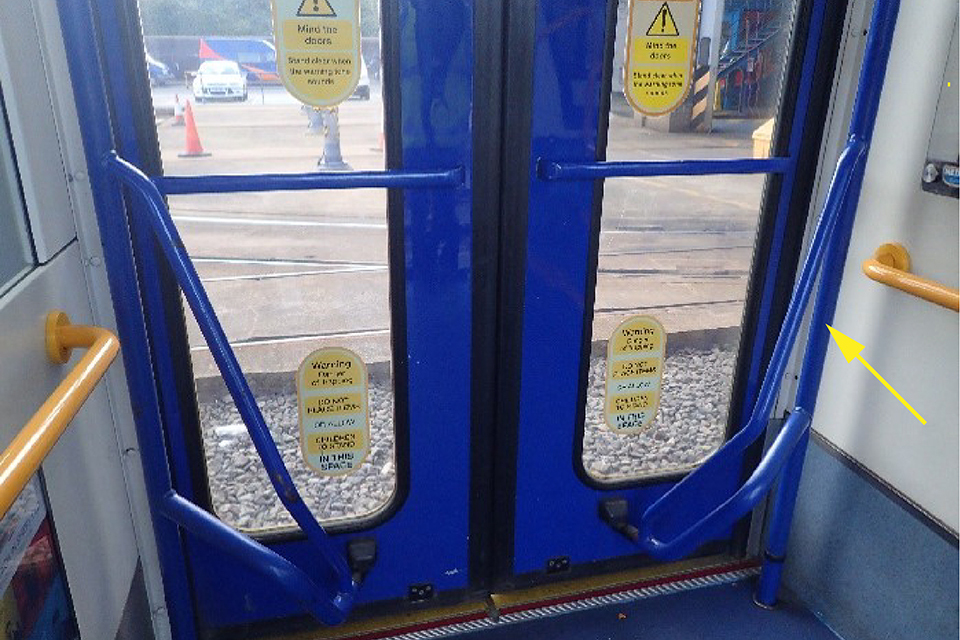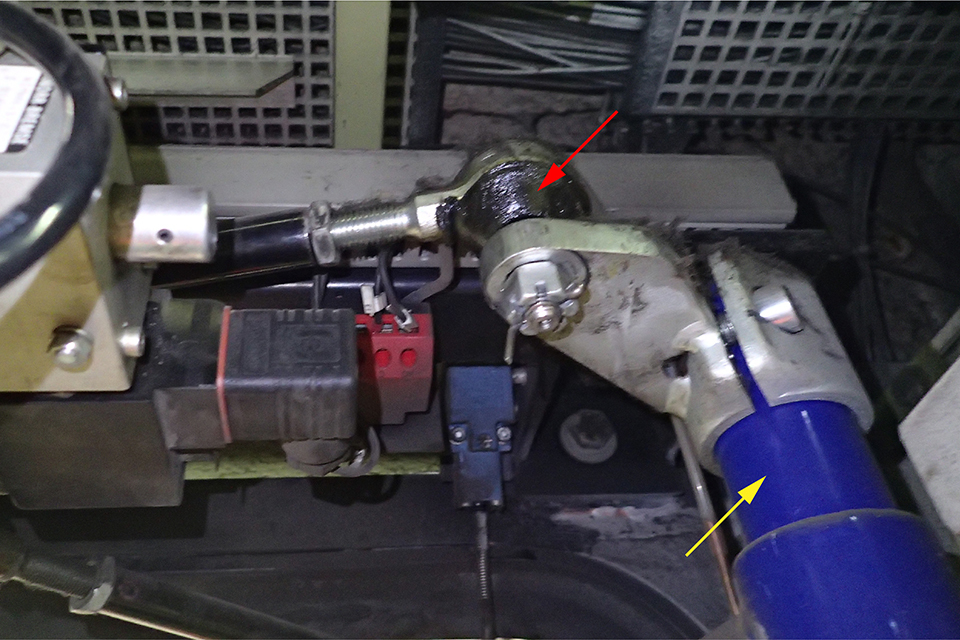Tram overspeeding on a curve, Sheffield, 19 July 2018
Published 28 September 2018
1. Important Safety Messages
This incident demonstrates the importance of:
- tram drivers taking special care when approaching high risk locations on the tramway, particularly where a substantial reduction in speed is necessary
- tram system owners and operators assessing operational risks particularly where trams approach curves with significant reductions in permitted speed and, where appropriate, ensuring that mitigations are in place
- tram doors preventing the ejection of passengers who may be thrown against them
2. Summary of the incident
At approximately 15:58 hrs on 19 July 2018, a tram on the Sheffield Supertram system entered a tight curve on the approach to Middlewood tram terminus at 23 mph (37 km/h). The maximum permitted speed at this location is 10 mph (16 km/h). The tram driver realised that he was going too fast just before the tram reached the curve and applied the emergency brake which brought the tram to a stand.
As a consequence of the tram’s speed entering the curve, passengers were subject to excessive lateral accelerations. One passenger suffered significant injury when she was thrown from her feet and collided with one of the tram’s exterior doors. The impact caused a component in the door system to fail, and the door to partially open. Although the passenger remained within the tram, she was injured and it is possible that she could have been ejected through the open door in slightly different circumstances.
It has been reported to the RAIB that at least one other passenger suffered a minor injury.

Tram 117, the tram involved in the incident. Photograph not taken at Middlewood.
The tram was to terminate at Middlewood which is approximately 2.7 miles (4.3 km) north west of Sheffield City Centre. The tramway approaching the terminus is integrated with Middlewood Road. Trams and road vehicles share the same alignment. The general speed limit on Middlewood Road, applicable to both trams and road vehicles, is 30 mph (48 km/h).
The track layout immediately before the Middlewood terminus includes a reverse curve. This allows trams travelling outbound, away from Sheffield city centre, to cross Middlewood Road and enter a holding area, clear from other road traffic. Due to the tight radius of these curves, a permanent speed restriction of 10 mph (16 km/h) applies at this location.

Middlewood terminus, showing the reverse curve and the direction of travel of tram 117
3. Cause of the overspeeding incident
The incident occurred because the tram driver lost awareness of where the tram was in relation to the curve. Consequently, he did not progressively reduce the tram speed down to the 10 mph (16 km/h) speed limit at the start of the curve on approach to Middlewood terminus. Drivers are reliant on their trained knowledge of the tram system to be aware of their location, and hence the appropriate speed. A sign to remind drivers of the reduced speed limit is provided at the start of the curve, but there were no advance markers relating to the reduction in permissible speed preceding this.
Since the incident, Stagecoach Supertram reports that it has implemented a ‘step down’ speed restriction of 20 mph (32 km/h) approximately 100 metres before the start of the curve at Middlewood, and advised its drivers accordingly. It has also identified another on-street curve with similar characteristics to the incident location and introduced a step down speed restriction there.

Approaching Middlewood terminus, viewed in the direction of travel of the tram. The 10 mph speed restriction sign can be seen on the blue pole to the left.
The RAIB found no evidence that the driver had fallen asleep or was fatigued. Testing carried out by Stagecoach Supertram showed that he was not under the influence of drink or drugs. Although he was a relatively newly qualified driver, he was familiar with the location and had driven to Middlewood on many previous occasions.
4. Cause of the door opening
The doors fitted to this type of tram are of the ‘swing plug’ type. Each tram has four doorways on each side, and there are two door leaves at each doorway. Opening and closing the door leaves is effected by a vertical rotating shaft connected to each door leaf. An air-powered actuator is connected to the top of each vertical shaft by a ball joint. Actuation of the air cylinder causes rotation of the shaft and the door to open or close. Mechanisms within the door system lock the door when closed, and also detect when the door is correctly closed and locked.
When the passenger was thrown against the door, the connection between the ball joint and the vertical shaft fractured. The arrangement of the door mechanism is such that failure of this ball joint disconnected the vertical rotating shaft and its corresponding door leaf from the locking mechanism. The door leaf then became free to open.

The doors on a Sheffield tram. The rotating vertical shaft is arrowed yellow.

Part of the door operating mechanism. The rotating vertical shaft is arrowed yellow. The ball joint which failed is arrowed red.
Stagecoach Supertram have commenced a programme to check the condition of all the ball joints fitted to these doors. Work is also underway to develop an alternative design. It is believed that the Sheffield Supertrams are the only UK tram to use this design of door system.
5. Previous similar occurrence
On 9 November 2016, a tram overturned at Sandilands junction on the Croydon tram system due to overspeeding on a curve. As a consequence, seven passengers died and 61 were injured, 19 seriously. The RAIB’s investigation concluded that the most likely cause was that the driver temporarily lost awareness. See RAIB report 18/2017. The RAIB investigation made 15 recommendations. Of these, four are pertinent to the incident at Middlewood.
Sandilands recommendation 2 required UK tram operators, owners and infrastructure managers to jointly conduct a systematic review of operational risks and control measures associated with the design, maintenance and operation of tramways, including consideration of the factors that affect driver attention and alertness.
Sandilands recommendation 3 related to the development of measures to automatically reduce tram speeds if they approach high risk locations at speeds which could result in derailment or overturning.
Sandilands recommendation 5 related to the review of signage, lighting and other visual information cues provided on segregated and off-street areas to assist drivers on the approaches to high risk locations such as tight curves. It also called for the consideration of in-cab warnings to tram drivers on the approach to high risk locations as an interim measure, ahead of the introduction of any future automatic tram speed interventions. The focus of the Sandilands recommendation was on tram operation in segregated and off-street areas. However, while on-street tramway sections generally operate at lower speeds than off-street sections, the circumstances of the incident at Middlewood demonstrate that there is potential for serious harm arising from similar overspeeding hazards when operating on on-street sections also.
Sandilands recommendation 6 related to identifying means of improving the passenger containment provided by tram windows and doors. At Sandilands, all seven fatalities and many of the serious injuries which occurred were due to passengers being ejected from the tram after it had overturned. The forces imparted to the door by the falling passenger during the Middlewood incident were likely to have been much lower than those caused by the overturning tram at Sandilands, however a door leaf still came open.

